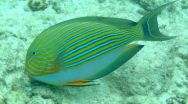Scientists with the National Space Biomedical Research Institute (NSBRI) have developed tools that expand the use of ultrasound during spaceflight and on Earth, especially in rural and underserved locations. These tools include techniques that streamline training and help remote experts guide non-physician astronauts to perform ultrasound exams. Ultrasound can be used to assess numerous conditions – fractured bones, collapsed lungs, kidney stones, organ damage and other ailments – in space and on Earth. With an NSBRI grant, they also created a catalog, or atlas, of "space-normal" imagery of the human body, setting the stage for astronauts to provide care without consulting a physician on Earth. This atlas was handed over to NASA earlier this year.
Dr. Scott A. Dulchavsky, the Roy D. McClure Chairman of Surgery and Surgeon-in-Chief at the Henry Ford Hospital in Detroit, is the principal investigator of these projects and is a member of the NSBRI Smart Medical Systems and Technology Team. "The ultrasound imagery techniques came from space program constraints of not having a trained radiologist on orbit or having a CAT scan or an MRI available, forcing us to use ultrasound for things in which we would not normally use it," he said. "Also, time limitations forced us to put some tight brackets around what is absolutely required for training to be able to obtain a high-quality ultrasound image and to make some sense out of the image."
Dulchavsky and colleagues from NSBRI, NASA, Henry Ford and Wyle Integrated Science and Engineering Group began their first ultrasound experiment -- Advanced Diagnostic Ultrasound in Microgravity (ADUM) -- by developing exam techniques for use on the International Space Station (ISS). The goal was for ISS crewmembers to collect high-quality ultrasound images to send to the Mission Control Center for analysis. The ADUM research was split into two projects: NSBRI funded the ground portion of the research, while NASA supported the flight portion.
The researchers conducted 80 hours of ultrasound examinations on the ISS and then sifted through approximately 20,000 images and many hours of video collected during ISS Expeditions 8 through 12 to create the "space-normal" atlas. The researchers developed the intuitive ultrasound guide to give astronauts broader use of ultrasound in additional organ systems and medical problems that were not part of the ISS experiment. Dulchavsky said, "ADUM initially utilized telemedicine and tele-ultrasound operations in which the astronauts were interacting with researchers and flight controllers on the ground during the examinations. The ultrasound intuitive guide allows astronauts to conduct exams when quick communication with an expert is not available due to distance from Earth or other reasons."
One of the first to be trained and to conduct an ultrasound exam in space was former NASA Astronaut and ISS Expedition 10 Commander Dr. Leroy Chiao. "We demonstrated on the International Space Station that even non-physicians can produce diagnostic-quality ultrasound images using remote guidance," said Chiao who is chairman of the NSBRI User Panel and a member of Baylor College of Medicine's Center for Space Medicine. "These ultrasound exam techniques and atlas will be increasingly important as we venture farther and longer into space. Telemedicine using ultrasound will be an invaluable medical diagnostic tool."
The level of skill needed to accurately analyze ultrasound exam results will vary based on the exam's goal. "To diagnose a broken bone is relatively straight-forward. When we were trialing this at my hospital, we trained the custodial personnel to conduct exams. After about five minutes, they had a diagnostic accuracy in the high 90s," Dulchavsky said. "Alternatively, if you are trying to look at subtle changes in how the heart functions in zero-gravity after six months, that takes considerably more expertise, and may take hours or even days of evaluation to do."
As in space, low costs and reduced-resource consumption make ultrasound an attractive option on Earth, but until recently, the lack of trained personnel has been an issue. Based on their research for NSBRI, Dulchavsky and his colleagues have spun off the techniques for terrestrial use and published "The ICU Ultrasound Pocket Book" – a reference guide for conducting examinations.
"The American College of Surgeons, which is charged with continuing education of surgeons in our country, saw the methods we developed for space and has now incorporated these techniques in its ultrasound training courses for all of the surgeons in the United States," Dulchavsky said. "Similarly, medical schools are starting to incorporate this training for all medical students, not just surgeons."
The ultrasound imaging techniques are also being used by athletic trainers for some professional sports teams and the United States Olympic Committee to get point-of-care rapid information about athletes' injuries.
However, it is rural locations, both inside and outside the United States, that stand to gain the most from the diagnostic ultrasound capabilities and telemedicine. Dulchavsky has been collaborating with the World Interactive Network Focused on Critical UltraSound (WINFOCUS) to train individuals to use ultrasound techniques in under-served regions.
"The use of ultrasound truly enhances people's opportunities to access and provide accurate, immediate, cost-effective health care," said Dr. Luca Neri, director of the WINFOCUS Global Ultrasound Program, and scientific chair of the "Point-of-care Lombardia UltraSound" project at Niguarda Ca' Granda Hospital and AREU EMS Public Regional Company in Milan, Italy. "Particularly, within the resource-scarce communities and health-care systems, we are successfully building upon the innovative ultrasound and telecommunication technologies developed by Dr. Dulchavsky for NSBRI and NASA and integrating their capabilities into the national health and education systems.
"By empowering local personnel to offer affordable, immediate, accurate, portable imaging, we facilitate earlier and more effective diagnosis, treatment and follow-up of patients on a broader basis and in a more sustainable manner."
Some of the countries in which the ultrasound techniques are being implemented to foster sustainable primary health-care development are Mozambique, Lesotho, Madagascar, India, Brazil and Nicaragua, with programs planned in Honduras, Congo and Malaysia. Tele-ultrasound has also been performed by Dulchavsky's team on Mount Everest and in the high Arctic Circle. During the past four years, Dulchavsky and Neri gave regular updates about ultrasound potentials at the United Nations' Economic and Social Council and the Observatory for Cultural and Audiovisual Communication in the Mediterranean and in the World InfoPoverty conferences in Geneva and New York.
In addition to Dulchavsky's work, the NSBRI Smart Medical Systems and Technology Team portfolio contains projects developing other innovative ultrasound technologies. One project is developing an ultrasound system to measure bone density and quality and accelerate fracture healing. Another project is developing a system for bloodless tumor removal, internal bleeding treatment and kidney stone reduction.
###
NSBRI is a NASA-funded consortium of institutions studying the health risks related to long-duration spaceflight and developing the medical technologies needed for long missions. NSBRI is headquartered at Baylor College of Medicine in Houston, with its science, technology and education projects taking place at more than 60 institutions across the United States. In addition to protecting astronaut health, NSBRI research has benefits for health care on Earth. For more information about NSBRI, please visit www.nsbri.org.
Note: The release and images are available at http://www.nsbri.org/newsflash/indivArticle.asp?id=454&articleID=143
END


